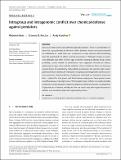Files in this item
Intragroup and intragenomic conflict over chemical defense against predators
Item metadata
| dc.contributor.author | Best, Rebekah | |
| dc.contributor.author | Ruxton, Graeme D. | |
| dc.contributor.author | Gardner, Andy | |
| dc.date.accessioned | 2018-02-19T11:30:05Z | |
| dc.date.available | 2018-02-19T11:30:05Z | |
| dc.date.issued | 2018-03 | |
| dc.identifier | 252124774 | |
| dc.identifier | 6ffd41e8-3fb9-4786-9227-4cee34ec881c | |
| dc.identifier | 85042160393 | |
| dc.identifier | 000428522100022 | |
| dc.identifier.citation | Best , R , Ruxton , G D & Gardner , A 2018 , ' Intragroup and intragenomic conflict over chemical defense against predators ' , Ecology and Evolution , vol. 8 , no. 6 , pp. 3322-3329 . https://doi.org/10.1002/ece3.3926 | en |
| dc.identifier.issn | 2045-7758 | |
| dc.identifier.other | ORCID: /0000-0001-8943-6609/work/60427497 | |
| dc.identifier.uri | https://hdl.handle.net/10023/12748 | |
| dc.description | AG is supported by a NERC Independent Research Fellowship (NE/K009524/1). | en |
| dc.description.abstract | Insects are often chemically-defended against predators. There is considerable evidence for a group-beneficial element to their defences, and an associated potential for individuals to curtail their own investment in costly defence whilst benefitting from the investments of others, termed “automimicry”. Although females in chemically-defended taxa often lay their eggs in clusters, leading to siblings living in close proximity, current models of automimicry have neglected kin-selection effects, which may be expected to curb the evolution of such selfishness. Here we develop a general theory of automimicry that explicitly incorporates kin selection. We investigate how female promiscuity modulates intragroup and intragenomic conflicts over investment into chemical defence, finding that individuals are favoured to invest less than is optimal for their group, and that maternal-origin genes favour greater investment than do paternal-origin genes. We translate these conflicts into readily-testable predictions concerning gene-expression patterns and the phenotypic consequences of genomic perturbations, and discuss how our results may inform gene discovery in relation to economically-important agricultural products. | |
| dc.format.extent | 8 | |
| dc.format.extent | 392624 | |
| dc.language.iso | eng | |
| dc.relation.ispartof | Ecology and Evolution | en |
| dc.subject | Automimicry | en |
| dc.subject | Cochineal | en |
| dc.subject | Genomic imprinting | en |
| dc.subject | Inclusive fitness | en |
| dc.subject | Kin selection | en |
| dc.subject | Predation | en |
| dc.subject | QH301 Biology | en |
| dc.subject | QH426 Genetics | en |
| dc.subject | QL Zoology | en |
| dc.subject | T-NDAS | en |
| dc.subject.lcc | QH301 | en |
| dc.subject.lcc | QH426 | en |
| dc.subject.lcc | QL | en |
| dc.title | Intragroup and intragenomic conflict over chemical defense against predators | en |
| dc.type | Journal article | en |
| dc.contributor.sponsor | NERC | en |
| dc.contributor.institution | University of St Andrews. School of Biology | en |
| dc.contributor.institution | University of St Andrews. Centre for Biological Diversity | en |
| dc.identifier.doi | 10.1002/ece3.3926 | |
| dc.description.status | Peer reviewed | en |
| dc.identifier.grantnumber | NE/K009524/1 | en |
This item appears in the following Collection(s)
Items in the St Andrews Research Repository are protected by copyright, with all rights reserved, unless otherwise indicated.

